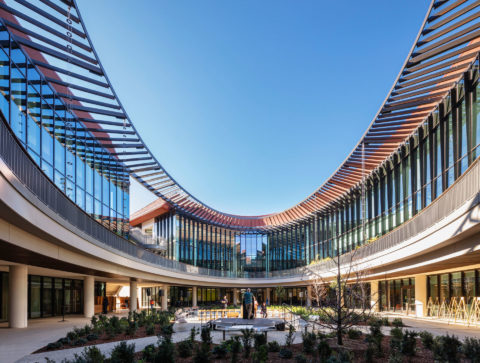
Stanford University Sarafan ChEM-H (Chemistry, Engineering & Medicine for Human Health) and the Wu Tsai Neurosciences Institute
Groundbreaking research in biochemistry and neuroscience converge in a single building in order to draw together a wide range of disciplines, including quantitative sciences, chemistry, molecular biology, genetics, psychology, bioengineering and the social sciences. The new interdisciplinary research complex is designed to serve as both a magnet for campus research and life, and as a gateway between the School of Medicine to the north and the Science and Engineering quad to the south.
Designed to innovatively co-locate two emerging research institutes – Stanford Neurosciences Institute and Stanford Chemistry, Engineering Medicine and Human Health (ChEM-H), the building houses leading and rising scientific minds investigating fundamental problems in neuroscience, chemistry, engineering, and medicine.
The building’s massing and activated ground floor plan take advantage of its pivotal location on campus by creating pathways that connect to the School of Medicine and the Science and Engineering Quad. As a result, the building becomes a crossroads to these increasingly convergent disciplines of mind, brain and behavior, bioengineering and the complex chemistry of life – opening the way to discoveries that will improve human health and eradicate disease.
The design creates outdoor spaces that are inviting, inspiring and interactive. These spaces are accessible and appealing for extending conference and social functions beyond the walls of the building. The ground floor is conceived as porous and open to the surrounding campus.
The building’s central location allows the new building to be a meeting place for lunch, coffee and evening drinks, providing researchers who have spent long hours in the lab a hangout spot to relax and interact in a less formal setting. A pub at the most active corner of the site anchors the building to its context and provides an area of respite and informality.
Designed to promote interdisciplinary collaboration, various meeting spaces and select research core facilities are shared and strategically located to be accessible and visible to both building occupants and visitors. A departure from conventional lab planning, the generous light filled “living room” spaces are created around the central landscaped courtyard and shared by lab "neighborhoods". These "living rooms" provide break out spaces, kitchenettes and shared meeting rooms to further promote collaboration between scientists in neighborhood labs of either institute as well as between visitors from other departments.
Research labs for both institutes are designed to be flexible, reconfigurable and integrated, allowing multiple disciplinary approaches to promote creative interactions. Open living room spaces linked by a common "race track" circulation zone organize the building into distinct research "neighborhoods”, and encourage collaboration and discussion. To achieve the desired balance of diversity and strength in faculty, the building will house approximately 40 Principal Investigators.
The three story Neuroscience Institute’s (SNI) theory/computational lab located inside a large living room is conceived as a compact vertical core “building within the building”. By providing a common conference room and a gathering space with a kitchenette, the building is designed to promote vertical circulation, visibility and collaborations among theorists, computationalists and experimentalists. This common space can open up to the larger neighborhood living room at times to host discussions or events, such as their traditional Friday Tea Time.
In addition to these shared facilities, large multipurpose rooms are designed to host important events or visiting lecturers.
Details
- Year
- 2020
- Location
- Stanford, CA
- Size
- 231,883 GSF
- Program
- Wet, dry and computational/theory research laboratories, Laboratory core programs, Animal Research Facility with below grade connections to existing facilities, Large Multi-Purpose Meeting Space, Meeting Interaction Spaces, "Living Room" Common Space, Administrative Spaces, PI Offices, Break Room Spaces and a Pub
Team
- Ennead Design Team
- Richard Olcott, Timothy Hartung, Stephen PD Chu, Don Weinreich, Steven Peppas, Craig McIlhenny, Bernardo Almonte, Gary Anderson, Billy Erhard, Corinna Ganssloser, Kyo-Young Jin, Jazzy Li, Marcel Merwin, David Monnar, Paul Scrugham, Fernando Suarez, Na Sun, Mark Talbot, Minh Tran, Melanie Weismiller, Desiree Wong, Dunia Wong
- Laboratory Consultant
- GL Planning & Design, Inc.
- Photographer
- Bruce Damonte
Awards
- 2024
- 2023
- SEFA Lab of the Year
- Chicago Athenaeum American Architecture Awards






























